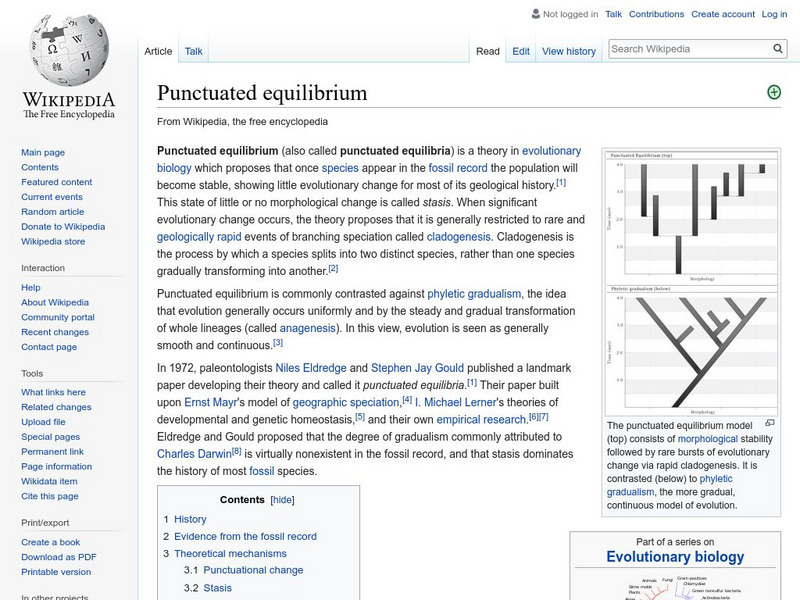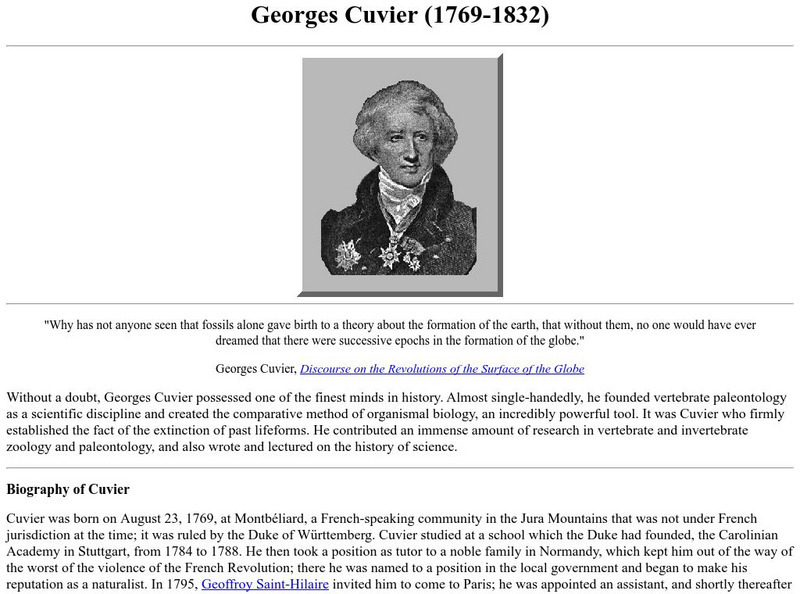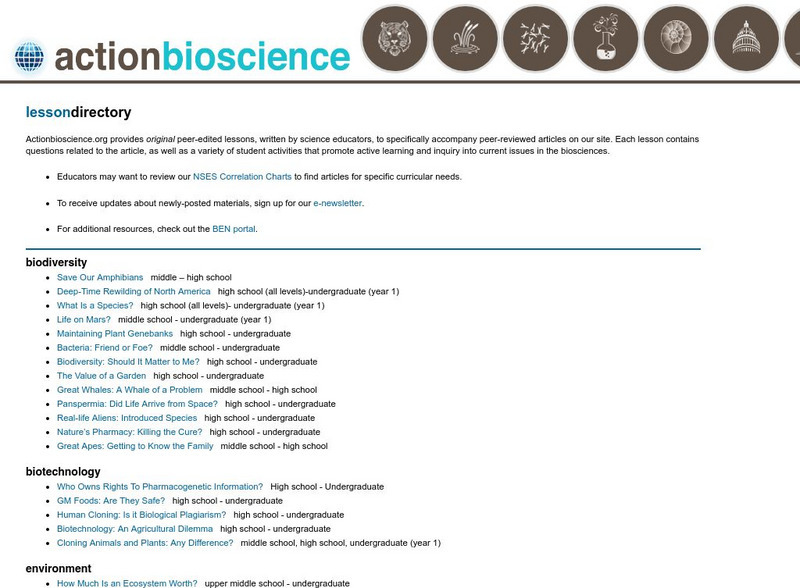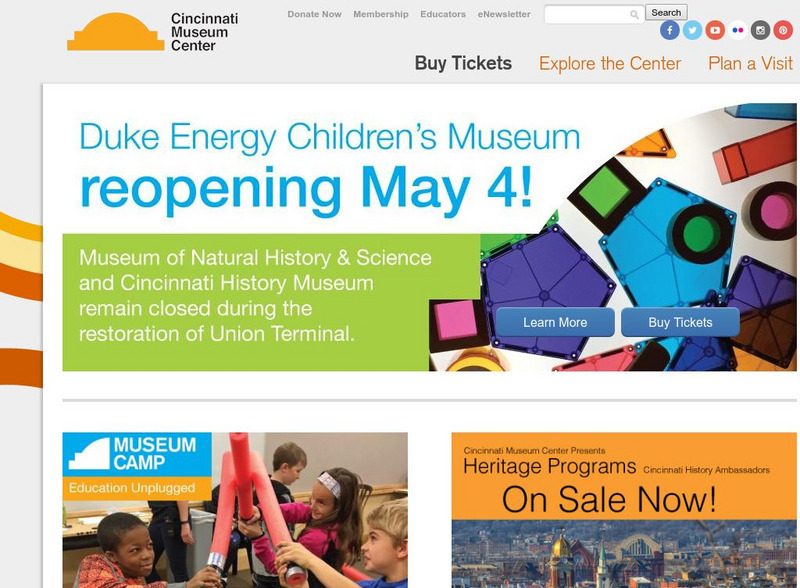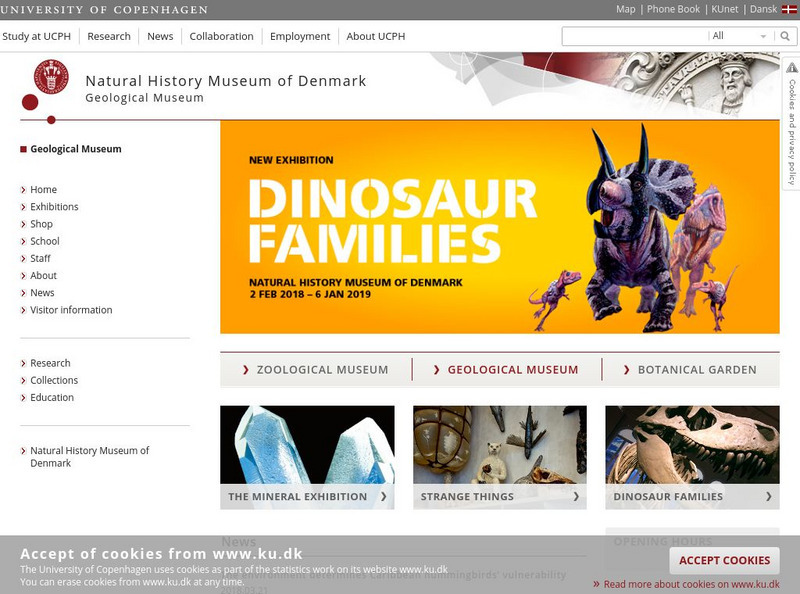Open Curriculum
Open Curriculum: Studying the History of Life
This in-depth article illustrates the concept of geologic time, and helps the learner understand why fossils are rare.
Other
Utct Digi Morph: Digital Morphology the University of Texas
A dynamic archive of information on digital morphology and high-resolution X-ray computed tomography of biological specimens.
PBS
Pbs Online News Hour: Putting Anthrax in History
This lesson is a WebQuest which highlights the anthrax attacks of October 2001. Students will be able to identify what anthrax is, list its symptoms and treatments, and identify different forms of the disease.
BiologyWise
Biology Wise: Microevolution vs. Macroevolution
The concepts of microevolution and macroevolution are explained and a two-column table that compares them is presented.
National Health Museum
Nhm: Restriction Maps to Cladograms Lesson
This lesson plan requires students to analyze DNA restriction maps to determine the differences in the sequence for several primates and humans. They then use the information to create a cladogram.
Wikimedia
Wikipedia: Punctuated Equilibrium
This brief explanation of punctuated equilibrium includes paragraphs on the history of the theory and the controversy surrounding it.
University of California
Ucmp: Georges Cuvier
This site from the University of California, Berkeley offers a biography of George Cuvier. Scientific ideas of George Cuvier are presented, such as those related to comparative anatomy, fossils, the idea of extinction, and others....
CK-12 Foundation
Ck 12: Life Science: 1.2 Fields in the Life Sciences
Explore some different areas of study in the life sciences.
CK-12 Foundation
Ck 12: Life Science for Middle School
This digital textbook covers core life science concepts and includes interactive features, real-world examples, and videos.
American Institute of Biological Sciences
Action Bioscience: Lesson Directory
Peer-edited, educator written science lessons on current bioscience issues. Each lesson correlates to a peer-reviewed article on that topic, and contains questions about the article and a variety of engaging activities for students.
TED Talks
Ted: Ted Ed: The Game Changing Amniotic Egg
April Tucker peels back each layer of the amniotic egg, revealing how truly extraordinary this evolutionary marvel is. [4:30]
TED Talks
Ted: Ted Ed: Pruney Fingers: A Gripping Story
Why do fingers become pruney when they get wet? Mark Changizi examines the evolutionary reasons for pruney fingers, while exploring natural and manmade phenomena, like river networks, that operate similarly. [4:22]
Other
Cincinnati Museum Center
This site describes the Museum of Natural History and Science in detail and provides links to other programs and exhibits offered.
Other
Natural History Museum of Denmark: Geological Museum
This site contains brief information about this natural history museum. Also contained are links to other museums (zoological, geological, botanical).
Other
Swedish Museum of Natural History
This resource can be viewed in Swedish or English. Some informational links are in Swedish only.
Vision Learning
Visionlearning: Cell Biology: Membrane Bound Organelles
Evidence in support of endosymbiosis to show the evolution of organelles within cells.
Other
Clermont College: Natural Selection and Speciation
Discusses natural selection and explains this theory in detail in reference to the evolution of the peppered moth. Discusses how the forces of natural selection lead to other kinds of speciation and evolutionary processes.
CK-12 Foundation
Ck 12: Genetic Variation in Organisms
Genetic variation helps ensure the survival of a species. It is this variation that is the essence of evolution. Without genetic differences among individuals, "survival of the fittest" would not be likely. This activity discusses how...
CK-12 Foundation
Ck 12: Types of Mutation
[Free Registration/Login may be required to access all resource tools.] Everyone has mutations. Mutations are essential for evolution to occur. This tutorial defines mutations and explains the different types: somatic mutations, germline...
CK-12 Foundation
Ck 12: Episd: Predation
[Free Registration/Login may be required to access all resource tools.] Discover the predator prey relationship and the ways organisms adapt to predation. Understand the impact predation has on population size and evolution.
Curated OER
Pelagic Shark Research Foundation: Evolution of Sharks
Decent overview of the sharks place in the geologic history.
Curated OER
Pelagic Shark Research Foundation: Evolution of Sharks
Decent overview of the sharks place in the geologic history.
Curated OER
Pelagic Shark Research Foundation: Evolution of Sharks
Decent overview of the sharks place in the geologic history.
Curated OER
Pelagic Shark Research Foundation: Evolution of Sharks
Decent overview of the sharks place in the geologic history.






